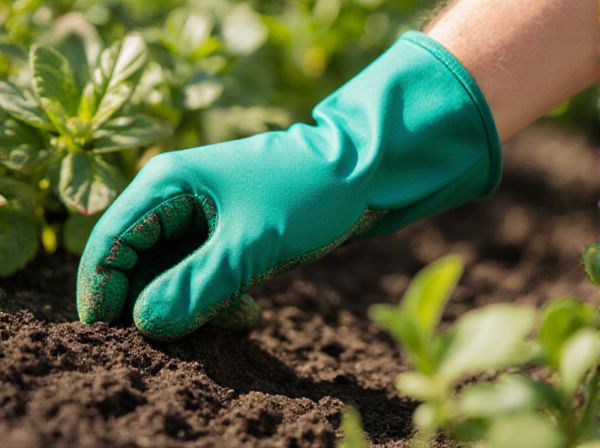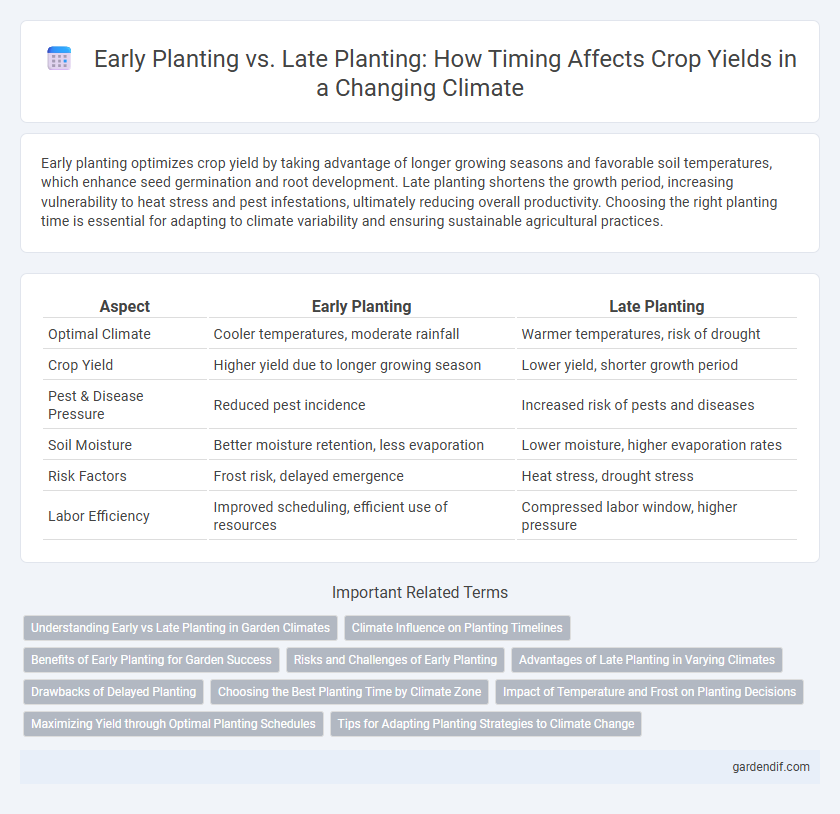
Early planting vs Late planting Illustration
Early planting optimizes crop yield by taking advantage of longer growing seasons and favorable soil temperatures, which enhance seed germination and root development. Late planting shortens the growth period, increasing vulnerability to heat stress and pest infestations, ultimately reducing overall productivity. Choosing the right planting time is essential for adapting to climate variability and ensuring sustainable agricultural practices.
Table of Comparison
| Aspect | Early Planting | Late Planting |
|---|---|---|
| Optimal Climate | Cooler temperatures, moderate rainfall | Warmer temperatures, risk of drought |
| Crop Yield | Higher yield due to longer growing season | Lower yield, shorter growth period |
| Pest & Disease Pressure | Reduced pest incidence | Increased risk of pests and diseases |
| Soil Moisture | Better moisture retention, less evaporation | Lower moisture, higher evaporation rates |
| Risk Factors | Frost risk, delayed emergence | Heat stress, drought stress |
| Labor Efficiency | Improved scheduling, efficient use of resources | Compressed labor window, higher pressure |
Understanding Early vs Late Planting in Garden Climates
Early planting leverages warmer soil temperatures and longer growing seasons, promoting faster germination and increased crop yields in temperate garden climates. Late planting reduces risks of frost damage but may shorten the growth period, potentially limiting plant maturity and productivity in regions with shorter summers. Gardeners must assess local climate patterns, frost dates, and soil conditions to optimize planting schedules and maximize harvest success.
Climate Influence on Planting Timelines
Climate conditions such as temperature trends, precipitation patterns, and frost dates critically influence planting timelines by determining the optimal window for seed germination and growth. Early planting benefits from warmer soil temperatures and extended growing seasons but risks damage from unexpected frosts and insufficient soil moisture. Late planting mitigates frost risk and can align with peak rainfall periods, yet may shorten the growing season, adversely affecting crop yields and maturation.
Benefits of Early Planting for Garden Success
Early planting maximizes the growing season by allowing plants to establish strong root systems before peak heat, enhancing resilience to drought and pests. Cooler soil temperatures in early planting promote better seed germination and reduce the risk of disease compared to late planting. Early crops often yield higher and mature sooner, enabling multiple harvests and increasing overall garden productivity.
Risks and Challenges of Early Planting
Early planting poses increased risks such as frost damage, soil temperature fluctuations, and unpredictable weather patterns that can stunt crop germination and growth. Challenges include higher vulnerability to pests and diseases that thrive in cooler, damp conditions, as well as potential nutrient imbalances in cold soils. These factors can lead to reduced yields and compromised crop quality compared to late planting schedules.
Advantages of Late Planting in Varying Climates
Late planting allows crops to avoid early-season frost risks common in colder climates, reducing potential damage and yield loss. In warmer regions, delayed planting benefits from improved soil moisture availability, enhancing germination and root development. This timing also aligns crop growth with optimal temperature and rainfall patterns, promoting healthier plants and higher productivity.
Drawbacks of Delayed Planting
Delayed planting reduces crop yield potential by shortening the growing season and exposing plants to higher risks of pest infestations and adverse weather events. Late planting also disrupts optimal nutrient uptake, resulting in weaker plant development and increased vulnerability to drought stress. Furthermore, postponing planting dates can lead to mismatches in crop maturation and harvest timing, complicating field operations and market availability.
Choosing the Best Planting Time by Climate Zone
In climate zones with shorter growing seasons, early planting maximizes sunlight exposure and reduces frost risk, promoting stronger crop development. Conversely, in warmer or uncertain climates, late planting helps avoid heat stress and drought conditions during critical growth stages. Selecting the best planting time requires analyzing historical temperature, precipitation patterns, and frost dates specific to each climate zone.
Impact of Temperature and Frost on Planting Decisions
Early planting increases the risk of frost damage as seedlings are more vulnerable to low temperatures, which can stunt growth or kill young plants. Late planting reduces frost risk but exposes crops to higher temperatures during critical growth phases, potentially decreasing yield and quality. Optimal planting plans must balance temperature forecasts and frost dates to minimize stress and maximize crop productivity.
Maximizing Yield through Optimal Planting Schedules
Early planting takes advantage of longer growing seasons and cooler soil temperatures, promoting robust root development and higher biomass accumulation. Late planting reduces exposure to early-season frost but can limit the full growth potential due to shorter maturation periods and increased heat stress during critical growth stages. Optimizing planting schedules based on regional climate data, soil temperature thresholds, and crop-specific phenology maximizes yield by aligning growth cycles with favorable environmental conditions.
Tips for Adapting Planting Strategies to Climate Change
Early planting leverages warmer soil temperatures to promote faster germination and extended growing seasons, essential for adapting to rising global temperatures. Late planting may reduce heat stress during critical growth phases and align crop development with shifting rainfall patterns associated with climate change. Employing climate-resilient crop varieties and using real-time climate data enhances decision-making for optimal planting times, improving yield stability under changing environmental conditions.
Early planting vs Late planting Infographic

 gardendif.com
gardendif.com